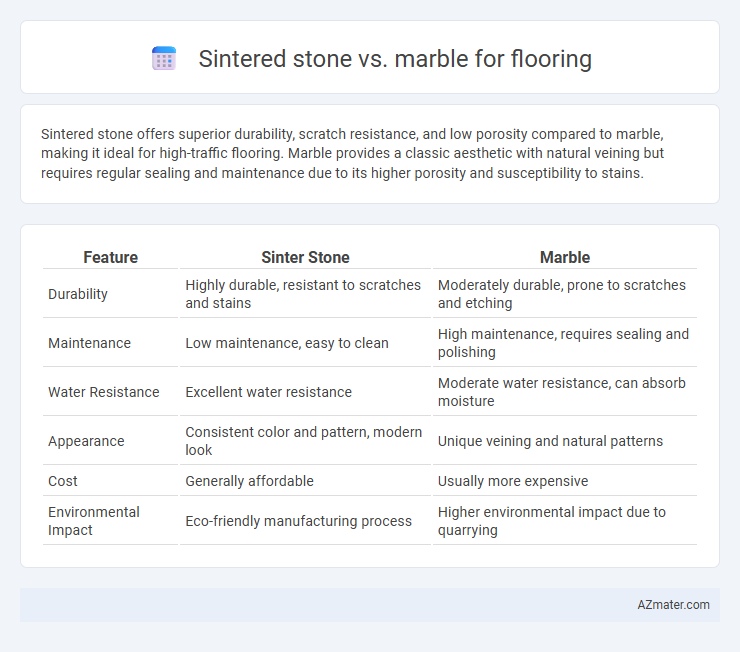Sintered stone offers superior durability, scratch resistance, and low porosity compared to marble, making it ideal for high-traffic flooring. Marble provides a classic aesthetic with natural veining but requires regular sealing and maintenance due to its higher porosity and susceptibility to stains.
Table of Comparison
| Feature | Sinter Stone | Marble |
|---|---|---|
| Durability | Highly durable, resistant to scratches and stains | Moderately durable, prone to scratches and etching |
| Maintenance | Low maintenance, easy to clean | High maintenance, requires sealing and polishing |
| Water Resistance | Excellent water resistance | Moderate water resistance, can absorb moisture |
| Appearance | Consistent color and pattern, modern look | Unique veining and natural patterns |
| Cost | Generally affordable | Usually more expensive |
| Environmental Impact | Eco-friendly manufacturing process | Higher environmental impact due to quarrying |
Introduction: Sinter Stone vs Marble Flooring
Sinter stone offers exceptional durability and resistance to scratches and stains compared to traditional marble flooring, making it ideal for high-traffic areas. Its non-porous surface resists moisture and requires minimal maintenance, whereas marble demands regular sealing to prevent damage from spills and humidity. The modern production process of sinter stone allows for diverse designs and consistent quality, contrasting with the natural variability and unique veining found in marble slabs.
Material Composition and Manufacturing Process
Sinter stone flooring is composed of natural mineral powders fused through high heat and pressure, creating a dense, non-porous surface with high durability and resistance to wear. Marble, a metamorphic rock primarily made of calcite, undergoes quarrying and cutting but lacks the enhanced structural density of sinter stone, making it more susceptible to scratching and staining. The manufacturing of sinter stone involves a controlled sintering process that results in consistent quality and performance, whereas marble's natural formation leads to unique variations but also variable durability.
Aesthetic Appeal and Design Versatility
Sinter stone offers a sleek, contemporary aesthetic with its uniform texture and wide range of colors, making it ideal for modern interior designs. Marble provides classic elegance with natural veining patterns that create unique, luxurious flooring options suited for traditional and high-end spaces. Both materials boast design versatility, but sinter stone's durability and customization options often provide greater creative freedom for innovative architectural projects.
Durability and Strength Comparison
Sinter stone offers superior durability and strength compared to marble, making it ideal for high-traffic flooring areas. Its dense, non-porous surface resists scratches, stains, and impact damage better than marble, which is more prone to wear and chipping. The enhanced hardness and low absorption rate of sinter stone ensure long-lasting performance and minimal maintenance demands in rigorous environments.
Resistance to Stains and Scratches
Sintered stone offers superior resistance to stains and scratches compared to marble due to its non-porous, compact structure and high durability. Marble, being a natural calcium carbonate stone, is more susceptible to etching and staining from acidic substances and requires regular sealing to maintain its surface integrity. For high-traffic areas or kitchens, sintered stone provides a more resilient and low-maintenance flooring option that withstands daily wear better than marble.
Maintenance and Cleaning Requirements
Sinter stone flooring offers superior resistance to stains, scratches, and heat, requiring minimal maintenance compared to marble, which demands regular sealing and careful cleaning to prevent etching and discoloration. Cleaning sinter stone involves simple wiping with mild soap and water, while marble needs specialized, pH-neutral cleaners to preserve its polished surface. The durability and low-maintenance nature of sinter stone make it ideal for high-traffic areas, whereas marble requires more attentive care to maintain its aesthetic appeal over time.
Environmental Impact and Sustainability
Sinter stone flooring is highly sustainable due to its production process, which uses natural raw materials and involves minimal waste and lower energy consumption compared to marble quarrying, which often results in significant environmental degradation and habitat disruption. Marble extraction generates substantial carbon emissions, water waste, and landscape scarring, whereas sinter stone's durability and low maintenance extend its lifecycle, reducing the need for frequent replacement. Choosing sinter stone over marble supports eco-friendly building practices by promoting resource efficiency and lowering the overall ecological footprint.
Cost and Value Considerations
Sinter stone typically offers a lower initial cost compared to marble while providing high durability and resistance to scratches, making it a cost-effective option for long-term flooring. Marble flooring, although more expensive upfront, adds significant aesthetic value and can increase property resale value due to its luxurious appearance and timeless appeal. Evaluating total lifecycle costs versus aesthetic and market value benefits helps determine the best flooring choice based on budget and investment goals.
Installation Process and Flexibility
Sintered stone flooring offers a more straightforward installation process due to its lightweight and uniform thickness, allowing for easier cutting and fitting compared to marble. Marble requires skilled craftsmanship to handle its natural variability and fragility during installation, which can increase labor time and costs. The flexibility of sintered stone permits use in various design applications, including large-format tiles and thin panels, whereas marble's rigidity and susceptibility to cracking limit its adaptability in complex layouts.
Best Applications and User Recommendations
Sinter stone offers exceptional durability and resistance to scratches and stains, making it ideal for high-traffic areas like kitchens and commercial spaces, while marble's natural elegance and unique veining provide a luxurious aesthetic suited for living rooms and bathrooms with moderate foot traffic. Users recommend sinter stone for modern, minimalist designs emphasizing longevity and low maintenance, whereas marble is favored for classic or sophisticated interiors where visual appeal is prioritized over extreme durability. Both materials require sealing, but sinter stone tends to need less frequent upkeep, making it the preferred choice for busy households and environments.

Infographic: Sinter stone vs Marble for Flooring
 azmater.com
azmater.com